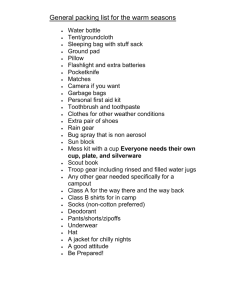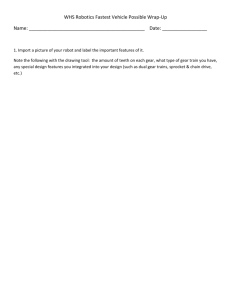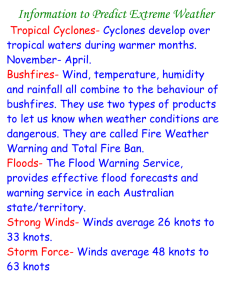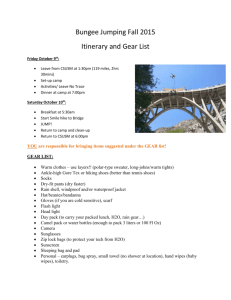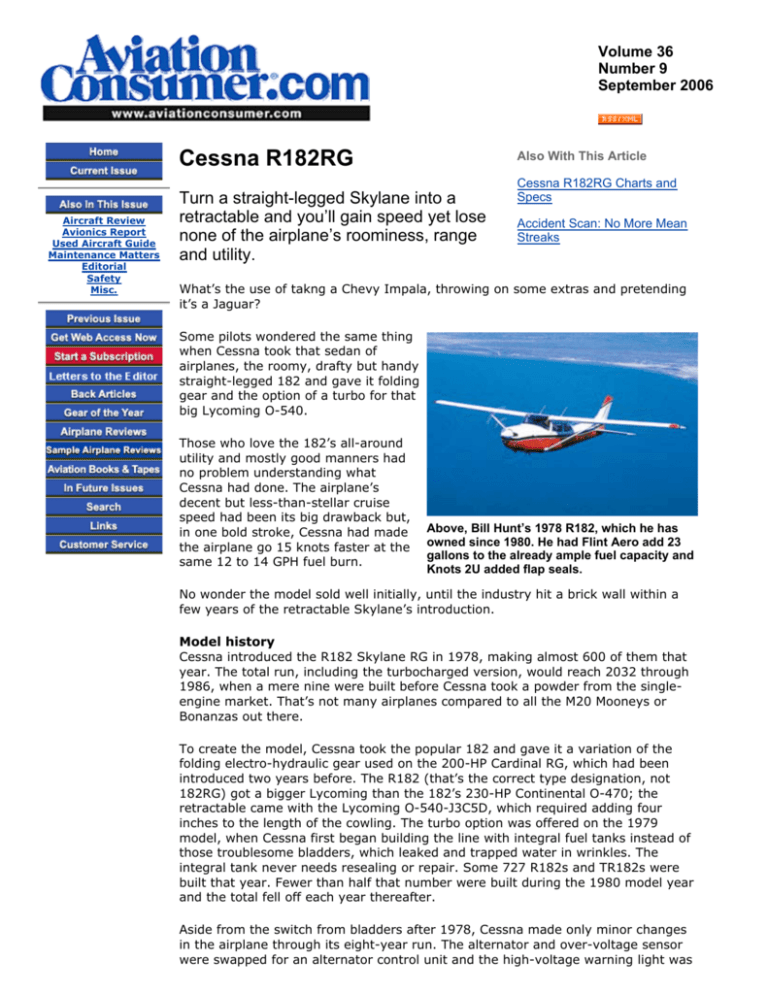
Volume 36
Number 9
September 2006
Cessna R182RG
Aircraft Review
Avionics Report
Used Aircraft Guide
Maintenance Matters
Editorial
Safety
Misc.
Also With This Article
Turn a straight-legged Skylane into a
retractable and you’ll gain speed yet lose
none of the airplane’s roominess, range
and utility.
Cessna R182RG Charts and
Specs
Accident Scan: No More Mean
Streaks
What’s the use of takng a Chevy Impala, throwing on some extras and pretending
it’s a Jaguar?
Some pilots wondered the same thing
when Cessna took that sedan of
airplanes, the roomy, drafty but handy
straight-legged 182 and gave it folding
gear and the option of a turbo for that
big Lycoming O-540.
Those who love the 182’s all-around
utility and mostly good manners had
no problem understanding what
Cessna had done. The airplane’s
decent but less-than-stellar cruise
speed had been its big drawback but,
in one bold stroke, Cessna had made
the airplane go 15 knots faster at the
same 12 to 14 GPH fuel burn.
Above, Bill Hunt’s 1978 R182, which he has
owned since 1980. He had Flint Aero add 23
gallons to the already ample fuel capacity and
Knots 2U added flap seals.
No wonder the model sold well initially, until the industry hit a brick wall within a
few years of the retractable Skylane’s introduction.
Model history
Cessna introduced the R182 Skylane RG in 1978, making almost 600 of them that
year. The total run, including the turbocharged version, would reach 2032 through
1986, when a mere nine were built before Cessna took a powder from the singleengine market. That’s not many airplanes compared to all the M20 Mooneys or
Bonanzas out there.
To create the model, Cessna took the popular 182 and gave it a variation of the
folding electro-hydraulic gear used on the 200-HP Cardinal RG, which had been
introduced two years before. The R182 (that’s the correct type designation, not
182RG) got a bigger Lycoming than the 182’s 230-HP Continental O-470; the
retractable came with the Lycoming O-540-J3C5D, which required adding four
inches to the length of the cowling. The turbo option was offered on the 1979
model, when Cessna first began building the line with integral fuel tanks instead of
those troublesome bladders, which leaked and trapped water in wrinkles. The
integral tank never needs resealing or repair. Some 727 R182s and TR182s were
built that year. Fewer than half that number were built during the 1980 model year
and the total fell off each year thereafter.
Aside from the switch from bladders after 1978, Cessna made only minor changes
in the airplane through its eight-year run. The alternator and over-voltage sensor
were swapped for an alternator control unit and the high-voltage warning light was
switched to a low-voltage light in 1979. The next year a new latch and pin system
was introduced to reduce the notoriously drafty fit of the doors—there are two on
the Skylane, which is as celebrated for its ease of entry and loading as it is reviled
(or patiently accepted) for its so-called "gappy" Cessna construction and fit.
In 1980, an avionics cooling fan became standard and the oil cooler was relocated
from the left forward baffle to the firewall. Also, the battery was moved from the
firewall to the less hostile environment of the tail cone and for easier access. A new
muffler for better cabin heating, especially in the rear seats, addressed another
Skylane complaint.
In 1983, Cessna replaced the amber "gear up" light, which stayed on if the gear did
not lock down, with a red "gear in transit" light, which stayed on whenever the gear
motor was running.
With the gear tucked up, the Skylane will build up speed when the nose drops. It
helps that the first 10 degrees of flaps can extend at 140 knots. In 1983, Cessna
beefed up the flaps further so they can be lowered to 20 degrees at up to 120
knots.
The wing root ventilators were redesigned in 1980, but they are known for getting
loose with age, spraying water into the cockpit in rain and popping open all by
themselves. Duct tape over the wing inlets is the standard field solution. Skylane
windshields also tend to leak and the R/TR182 is no exception. The only solution
that works is removing the windshield and resealing it. Watch for shops that use
silicone sealant instead of the proper felt stripping. Windshields expand and
contract; hardened silicone does not.
The R/TR182 has no main gear doors. But it does have nosegear doors and early on
they occasionally caught the cowling skin and got stuck. A 1983 redesign addressed
the problem. In 1984, the airplane got new composite fuel caps and rear-seat
shoulder harnesses as standard equipment. Dual controls became standard instead
of optional that year, but who’s seen any single-control Skylane RGs around?
Performance
The Skylane retractable is a solid cross-country airplane with a 150-knot cruise
commonly reported at a fuel burn of 12 to 14 GPH. With its 88-gallon usable
standard tanks (on 1979 and later models), it can go far. Its range and its 1200- to
1300-pound useful load give it lots of flexibility as a good hauler.
Those big tanks, which provide better range than early Mooneys and Bonanzas,
leave less of a useful load than a 250-HP Piper Comanche with full tanks—but that
comparison doesn’t do justice to the airplane’s flexibility.
With full fuel, four "standard" FAA grownups can go on a long trip—close to 1000
miles, depending —and share a single overnight bag. Fly with less fuel and you can
carry just about anything you can fit into the airplane and still fly for hours. We’ve
said it before and can’t resist saying it again: Your bladder can’t last as long as the
fuel supply when you cruise an R182 at lower power settings, say 55 to 60 percent.
Another big attraction is that the R182, with its big, fat wing, big flaps, high flap
extension speeds and good prop clearance, is just as handy getting into and out of
smaller airports and rougher fields as it is keeping up the speed on the ILS into a
Class Bravo airport even as it drops full flaps at the last minute and gets out of the
way at the first turnoff.
Try that in a Mooney. A few owners do complain, however, that because the tires on
the RG are smaller and inflated to higher pressures than those on the fixed-gear
Skylane, it can be a little squirrelly in crosswinds and harder to control on the
runway.
Its 235 horses also take some pilots by surprise when they pour on the coal: A
Mooney or Arrow pilot used to 200 HP might be surprised by the left-turning
tendency of the Skylane RG at full power and high pitch. These traits, and the
heaviness of the elevator, may explain a number of runway and go-around crackups over the years.
Comparisons are not made between the R182 and the Bonanza, which pilots do not
consider a lower-priced choice in the used market. So Aviation Consumer a few
years ago conducted a side-by-side flyoff between the R182 and a 201. It found the
R182 had the better climb rate and more dexterity getting into and out of a variety
of airports. The Cessna hauled more, both in weight and volume, and was a little
faster than the sleek 201, but of course at 20 to 40 percent more gallons per hour.
The turbocharged version is significantly faster after its easy climb into the low
teens, where it can achieve 165 knots TAS and more at higher altitudes. The
normally aspirated R182 climbs well, too, with 1000 FPM typical at lower altitudes at
gross weight and standard temperature. The turbo, its adoring pilots have told us,
will lope up to FL 200 at 1000 FPM the whole way up.
Handling, Cabin
In the air, the 182RG is a gentle, forgiving bear with a solid ride and feel. An Avcon
writer used it to practice airwork for his CFI certificate and found it gentler than a
172, unwilling to bite even in a fully cross-controlled stall. Still, it requires some skill
to fly well. It is not a feet-on-the-floor airplane like the Cherokee and its
derivatives.
Pilots who don’t use as much rudder to help roll out of a turn as they used rolling in
will wallow all over the sky. (They never seem to notice how far the ball slid outside
the cage.) The RG likewise needs nimble and firm rudder work on and near the
runway to keep the nose straight on takeoff and in crosswinds.
Most notorious is the heavy elevator feel, something you’d expect pulling back on a
DC-3 yoke. The heavy pitch and the Skylane’s brick-like descent rate with full flaps
and gear out—something you’d expect of the Space Shuttle—have led to a fair
number of hard landings and runway loss-of-control accidents. Don’t try to land
power-off with full flaps; the timing of the roundout and flare will be so critical as to
invite a hit or a drop. Keep some power in. Watch out especially for forward-CG
landings, with full fuel and only two aboard in the front seats. And before buying a
used Skylane RG, check the logs, gear and the firewall carefully for evidence of
damage.
The Skylane cabin is famously roomy and easy to access with a wide door on each
side and windows that open on both, in most models. The baggage door is low to
the ground and convenient. That big box of a cabin, however, flexes and the door
and windshield fit can get sloppy over the years. That makes for drafts and water
leaks. The original seats are okay except for their cheesy plastic and fabric. They
are adjustable in height and seatback angle with lots of parts and pieces. Watch out
for broken adjusters as well as worn seat tracks, the subject of a well-known AD
affecting many Cessna singles.
Maintenance
A look at the past 10 years of Service Difficulty Reports (1996 to 2006) confirms
that landing gear malfunctions and problems continue to top the list of R/RT182
maintenance woes. Out of 85 SDRs during that period, 17 or 20 percent had to do
with sheared bolts, failed downlock pins, cracked pivot assemblies, stuck doors and
the like.
That’s an improvement over the rate seen in earlier SDR reviews. Owners who
wrote us recently had no complaints about the gear. One said it’s better for grass
strips than the fixed-gear Skylane because it’s sturdy and there are no wheel pants.
Pilots who know how to avoid hard landings, we suspect, probably have landing
gear systems that work just fine (as long as a previous owner’s mistakes have been
properly repaired).
The next most common issues found in the SDRs were internal engine problems,
including worn or stuck valves (six out of 85); cracked spinner back plates, six
cases; magneto woes, such as missing teeth on the distributor gear, six cases; and
carburetor trouble, including a failed inlet nipple that allowed fuel to spray inside
the cowling and ignite, burning a hole in the belly aft of the firewall.
Shimmy damper problems have plagued the RG but do not stand out in the most
recent SDRs. A Cessna service bulletin (80-67) was aimed at correcting the problem
with a mod kit and it appears to have been successful. Also in the past, service
bulletins dealt with balky throttles. Any RG should have the recommended mods
installed.
Other complaints over the years have included instrument lights that flicker out,
leaks around the windshield and wing root, turbos leaking oil, shearing vacuum
pump drive shafts, poorly aligned aileron hinge cotter key holes, failing Bendix
starters, cracked exhaust stacks and worn alternator mount bolts.
Be aware that in the past, the R/RT182 had more than its share of bugaboos.
Recent history and owner comments suggest, however, that at least some of the old
RG problems have been ironed out. There have been no ADs specific to the RG
series in recent years. Notable old ones involve leaky flush-type fuel caps and
wrinkles in the 1978 fuel bladders that trapped water. More recently, AD 2000-0601 requires inspection of the fuel strainer assembly and, of course, AD 2005-19-11
is the infamous Lycoming crankshaft replacement directive.
Mods, Owner Group
The Cessna Pilots Association is a great source of information for all Cessna owners.
A membership is $45. Visit www.cessna.org/ to sign up. AOPA’s member section
(www.aopa.org/) has a great summary of the hundreds of mods available for the
Skylane, some of which can be applied to the RG series, including kits for drag
reduction, STOL performance, replacement tanks and caps for the 1978 bladders
and caps and backup vacuum and electrical systems. Well respected speed mods
come from Horton STOLcraft in Wellington, Kansas (620-326-2241) and Knots 2U,
Ltd. of Burlington, Wisconsin (262-763-5100, www.knots2u.com/). If there are still
RGs out there with the old bladders, Monarch Air and Development Inc. in Oakland,
Oregon has the fix (541-459-2056, www.airsport.com/).
Owner Feedback
I bought N79MR, a 1979 TR182, in 1998 with 4500 hours. It now has 5300 hours
and 450 SMOH, which included new Millennium cylinders and new three-blade prop.
I owned an Archer for 10 years and was looking for speed.
I’ve always favored high-wing aircraft.
My choice was between a 210 and a
182 RG and I figured with the 210, I
would be dragging a whole lot of
expensive empty metal behind me
most of the time. I would not get a
normally-aspirated model in California
due to the Sierras. I wanted an
aircraft that would carry four adults, a
full fuel load and some baggage at 150
knots-plus.
There was an elusive intermittent
gear-down lock switch problem that
took five annuals to correct and a
sticky turbo oil check valve that spit a
lot of oil on the left fuselage, wing
strut and gear strut. We replaced it but
Bill Hunt’s panel, upgraded in 2003 with
Garmin GNS530/430 GPS, a GTX 330
transponder and audio panel, Bendix/King
ADF, an HSI, flight director system, RMI and
STEC-55 autopilot.
I found that if the aircraft sits and is run up
to only intermediate settings, the check valve will allow oil to leak back into the
turbocharger and spit out the exhaust. Once you get a high-power cycle on the
engine and turbo, it acts normally. The O-540 is prone to a greasy bottom but a
properly installed Airwolf oil separator has helped tremendously.
I pay about $2500 for insurance. Annual this year was $6000 but $2200 was the
HSI and I asked them to troubleshoot the gear-down lock light until they found the
problem (a bad down-lock switch). Annuals average $2300 unless something
significant has broken.
It is an ideal cross-country aircraft with a decent 1000-mile range VFR. I will cruise
between 10,000 and 14,000 feet depending on terrain and winds. I plan for 150
knots at 12,500 with fuel flow of 12 GPH average. I get high oil temps at altitude
despite a good baffle seal. The oil cooler is half out of the airflow in the left front
cowl so it is probably not as efficient as it could be.
I’ve flown it side by side with a straight-leg 182 and, at similar power settings, the
RG literally walks away. The only drawback is the RG costs more for insurance and
the smaller wheels give me pause for going into dirt strips. It excels at the things
that are most important: safety, speed and reliability.
Captain Denny Breslin
via email
I own a 1978 182RG with a partner. Prior to that, I owned a 1979 Skyhawk. Our RG
has turned out to be a terrific cross-country machine: stable, fast, economical and
very comfortable, although the back seat can be a bit drafty in the winter.
It’s a load hauler, 770 pounds usable with full fuel and a generous CG envelope.
Fuel burn runs 10 to 11 GPH with a true airspeed of 150-plus knots. No surprises,
maintenance-wise: Our RG actually spends less time in the shop than our friend’s
Cirrus SR22. Our operating costs total $114.96 an hour (tach time). My Skyhawk
was around $97.
We replaced the original fuel bladder, doing most of the work ourselves. Our only
complaint is oil related. It’s difficult to get an accurate reading from the dipstick. We
can check the oil during pre-flight and it might read 6.5 quarts. After we land, it will
read 7.5 quarts.
The airplane is a dream to fly. An STEC 55 autopilot coupled to a Garmin GNS430
GPS makes a nice IFR platform. Transitioning to the RG from the Skyhawk was
straightforward, with more back pressure required on landing (lots of trim helps).
It’s easy to overshoot the airport on VFR descents with the gear and flaps up—it
loves to stay airborne.
Ed Reuss, Tim Hennessy
via email
I have been the happy and proud owner of a 1979 Cessna 182 Turbo RG for two
years. My wife and I chose it for the combination of cabin size, stability, comfort,
ease of entry, speed, range and payload. The turbo is wonderful for IFR operations.
The turbo eliminates the carb icing issue because it keeps the induction air warm.
An additional benefit is less noise. I have been told that the turbocharger acts as an
additional muffler. An additional safety feature in winter operations is the power to
climb on top to get out of icing.
Two doors and a wide cabin are important as we make many trips with our two
golden retrievers. Many of our trips are of the 400- to 900-mile length so speed is
important. Typically, we fly IFR at 8000 to 12,000 feet. TAS at 23 squared and
about 13 to 13.5 GPH runs about 156 to 158 knots at 10,000 feet. At 12,000 feet at
25 inches and 2400 RPM, I see 164 knots TAS. Range is excellent, with 89 usable
gallons. My TAS runs a bit higher than book, likely a reflection of the gap seals from
Knots 2U.
The aircraft is extremely stable. Flying the ILS is a piece of cake. It maintains the
trimmed airspeed solidly. It tracks the glideslope with 15 inches MP, 5 degrees of
flaps and 105 to 110 knots IAS. The ability to drop the landing gear at 140 knots
gives me greater flexibility in slowing down and getting lower if requested to do so
by ATC. The first 10 degrees of flaps can go down at speeds up to 140 knots IAS.
Load-carrying capability is great with a useful load of 1170 pounds. Short field
operation is easy. We routinely operate out of grass airstrips and, in a pinch, with
20 degrees of flaps, the aircraft will break ground at 45 knots. The landing gear is
very durable and we don’t have to worry about wheel pants getting damaged.
The Collins stack was costing a fortune to maintain and I felt it was too much of a
liability for IFR so we installed a Garmin stack. The airplane came with a slaved
Bendix/King HSI. I will not fly IFR without an HSI again.
One good feature is the reliability of the engine. I have spoken with many other
TR182 owners whose engines have made and exceeded TBO without a top overhaul.
That makes me feel better when I cross the Bay of Fundy at night. This was a major
selling point when comparing to the 210, which has a lower TBO and often does not
make it to TBO. Cost of operation has been reasonable and there have been no
maintenance surprises and no ADs. Insurance in Canada is running about $4000
(Canadian) per year.
Eric Versnick
Halifax, Nova Scotia
I recently bought into a three-person partnership in a 1978 R182. The aircraft has
very few bad habits but must be carefully managed during final approach,
touchdown and rollout.
Multiple gear-down checks are, of course, vital. Careful airspeed, pitch and power
control on final approach are important to avoid prodigious rates of descent on the
back side of the power curve or long airspeed-dissipation glides over the concrete. I
try to peg 70 KIAS or slightly less over the numbers. Vigilance is required during
touchdown and rollout. I think a lot of this has to do with the small high-pressure
tires (50 PSI nose, 68 PSI main).
The gear adds a lot to the utility of the airplane, even in this low-speed category.
We typically fly at 150 knots TAS on 12 GPH at 6000 to 8000 feet. With 75 gallons
useable, range is not an issue. Load-carrying capacity is excellent.
A Garmin GPSmap 396 is a very useful augmentation to our early-1980s vintage
radios (KX-155s, Loran, DME and ADF). The leaky cockpit can get pretty cold and
uncomfortable at high altitude in the winter, even with the heater going full blast.
One quirk of the R182 that I think also applies to the 210 is that exhaust enters the
cabin in flight unless the cabin is kept at positive pressure by opening either the
heater or the outside air intake. Another contributor to this potential problem is
that, with the mixture knob all the way in, the engine is running too rich. Total cost
of operation should be about $120 per hour.
The Cessna Pilots Association forums have been excellent. One of the jewels I
picked up is the fact that the aircraft (and other 182s also) makes a distinct howling
sound flying through rain. I’m glad I knew about that ahead of time!
John Wilson
Lebanon, New Hampshire
I’ve owned my normally aspirated R182 since August of 1980. It now has 3300
hours. I love this airplane! It’s relatively fast (150 knots TAS), has a great useful
load (about 1200 pounds) and has been cheap to keep. Annuals generally run
around $1000 with insurance at $1800 annually. Fuel burn is around 11.8 GPH in
cruise.
In 2001, I added 23 gallons to the existing long-range tanks with Flint Aero fuel
tanks, bringing my total fuel onboard to 98 gallons. That gives me quite a range,
about eight hours. I also added flap gap seals from Knots 2U, which gave me about
three additional knots at cruise.
I had the airplane painted using a paint scheme from Scheme Designers and a new
interior installed in 2002. The panel was upgraded in 2003 to include Garmin
GNS530 and 430 GPSs, along with a Garmin GTX 330 Mode-S transponder, GMA
340 audio panel, Bendix/King KR-87 ADF, KCS-55A compass system including an
HSI, KI-256 flight director system, KI-229 RMI and an STEC-55X autopilot.
Bill Hunt
Tucson, Arizona
I own a 1979 Cessna R182 with a partner. We are both A&P mechanics and have
done all the airframe maintenance including most of the work on the annuals
alongside the AI.
The engine was replaced with a factory
overhauled engine in 1997. We have
over 1000 hours on the engine and
have had success with it except for a
stuck valve at around 400 hours. It
was after returning from Phoenix in
112-degree weather, so that may
have been a factor.
We cruise at 2200 RPM and 22 inches
or full throttle at higher altitudes for
approximately 65-percent power and
plan on 14 GPH for the first hour and
12.5 GPH at cruise altitude. An engine
maintenance issue is the 500-hour AD Owner Eric Versnick and his wife carry two
golden retrievers aboard. Just try wedging
on the magneto. We’ve removed it
two large dogs into a Mooney.
and sent it to a local shop for a fresh
overhaul for about $300. We also use
fine wire plugs.
We have STCs for the air-oil separator and a cooling tube for the vacuum pump. We
have not had a failure and the belly is always clean. We have to replace the battery
about every two years. The 1980 and newer airplanes have the batteries in the tail
cone, where I assume it lasts longer away from the heat of the engine.
The landing gear is easily maintained. We have replaced the hoses a couple of
times. We have disassembled the powerpack a few times and have only replaced Orings and fluids. The motor brushes have little wear. We have disassembled the
main gear actuators and cleaned and inspected them. We found one of the sector
gears had been installed backwards with only two gears holding the landing gear
up. We replaced O-rings, reassembled and installed, per a service bulletin, safety
wire to the mount bolts.
A nosegear issue is to check the lock pins for movement and replace the plastic
spring with metal, per service bulletin. The early RGs had a problem with the
shimmy damper mount. That should be changed to the newer configuration.
It rides much lighter on the gear than a fixed-gear 182 because of the nose-up
attitude so crosswinds are trickier. It must be landed straight or it could get away
from you. It climbs much faster than a fixed-gear 182. We have climbed at over
500 FPM at 10,000 feet with four people and usually at 120 knots.
The 182RG has been safe and 15 knots faster than my old fixed-gear 182 at 65percent power.
Ray Tilton
via email
About Us / Contact Us / Privacy Policy / Site Map
Copyright Belvoir Media Group, LLC. All rights reserved.
ACCIDENT SCAN: no more mean streaks
We had to go back 20 years to get
a meaningful number of 182RG
accidents to analyze and even so
the total reached only 49. Seven
involved fatalities and four more
involved serious injuries.
If the 182RG had a mean
streak, it has been tamed a bit
since we last checked. Pilots losing directional control on or near
the runway accounted for nearly
half of all accidents we looked at
six years ago; now they account
for only 12 percent. Add loss
of control after lift-off on goarounds, and it’s 24 percent. Add
crack-ups after hard landings,
which we found to be a major
factor six years ago ­— we blamed
the Skylane’s notoriously noseheavy elevator feel — and the
total comes to 34 percent.
In six cases, pilots lost diaccident summary
engine failure (14%)
gear failure (12%)
RLOC (12%)
LOC on go-around (12%)
hard landing (10%)
gear-up (8%)
CFIT 6%
vfr into imc (6%)
overruns (4%)
aborted takeoff LOC (4%)
rectional control on rollout
or takeoff. The same number of
mishaps occurred after attempted
go-arounds, which led to either
flight into obstacles or a mush into
the trees. Five accidents followed
from hard landings, some of which
led to a bounce, a porpoise and a
crash.
But the most common accident
cause this time was engine failure.
There were seven cases of it. Only
one was the result of fuel exhaustion. Four had to do with maintenance-related problems. In the
only fatal case, the owner-operator
had not abided by an emergency
AD involving an oil filter converter
plate gasket.
Landing gear failures occurred
in six cases, with worn-out or
broken parts cited by the NTSB.
(Maybe there’s some connection to
the hard-landing phenomenon.)
Retractable Skylane jockeys landed
gear-up only four times, including
crunches that came after the gear
was inadvertently retracted.
The fatals had nothing to do
with the airplane: flying VFR into
IMC; canceling IFR to make an
approach visually in bad weather;
scud running; clipping trees on
climbout and spinning in; and
taking off IFR on a foggy night
and losing it with a spiral into
the ground. Wake turbulence on
approach behind a 737 rolled one
182RG with fatal consequences.
CESSNA R182RG
8 ft. 9 in.
36 ft.
Photo: Erik Versnick’s TR182 in Nova Scotia.
29 ft. 4.5 in.
Drawings courtesy www.schemedesigners.com
CESSNA 182RG MODEL HISTORY
MODEL YEAR
ENGINE
TBO
OVERHAUL
FUEL
USEFUL LOAD
CRUISE
TYPICAL RETAIL
19781984 R182 RG II
235HP LYC O540J3C5D
2000
$24,000
92
1290
156 KTS
±$130,000
19851986 R182 RG B
235HP LYC O540J3C5D
2000
$24,000
92
1290
156 KTS
±$155,000
19791984 TR182 II
235HP LYC O540L3C5D
2000
$24,000
92
1254
173 KTS
±$140,000
19851986 TR182 RG B
235HP LYC O540L3C5D
2000
$24,000
92
1254
173 KTS
±$168,000
CESSNA 182 RG RESALE HISTORY
1978 R182RG
1981 TURBO T182RG
140 K
115 K
SELECT HISTORICAL ADs
DATA:
SUMMER 2006
AIRCRAFT BLUEBOOK PRICE
DIGEST
90K
65 K
AD 05-19-11
LYCOMING 540 CRANKSHAFT
AD 00-06-01
FUEL STRAINER ASSEMBLY
AD 87-10-6
ROCKER ARM ASSEMBLY
AD 84-10-01
WATER IN BLADDERS 1978 ONLY
AD 83-13-01
LEAKING FUEL CAPS
40 K
1986
1990
1994
1998
2002
2006
SELECT LATEMODEL COMPARISONS
SOCATA TB-20 TRINIDAD
PA-28R-200 ARROW
CESSNA 182RG
MOONEY M20J/201
900
1984 TB-20 TRINIDAD
MOONEY M20J/201
SOCATA TB-20 TRINIDAD
700
1979 CESSNA TURBO 182RG
CESSNA TURBO 182RG
PA-24-250 COMANCHE
500
1979
PRICE COMPARISONS
CRUISE SPEEDS
PAYLOAD/FULL FUEL
1978 CESSNA 182RG
PA24-250 COMANCHE
1979 MOONEY M20J/201
CESSNA 182RG
1979 PA-28RT-201 ARROW IV
PA28R-200 ARROW
1100
1300
140
160
180
200
220
50K
1964 PA-24-250 COMANCHE
70K
90K
110K
130K

